Israel’s May 2019 Issues:
Click on the issue names to go the specific pages.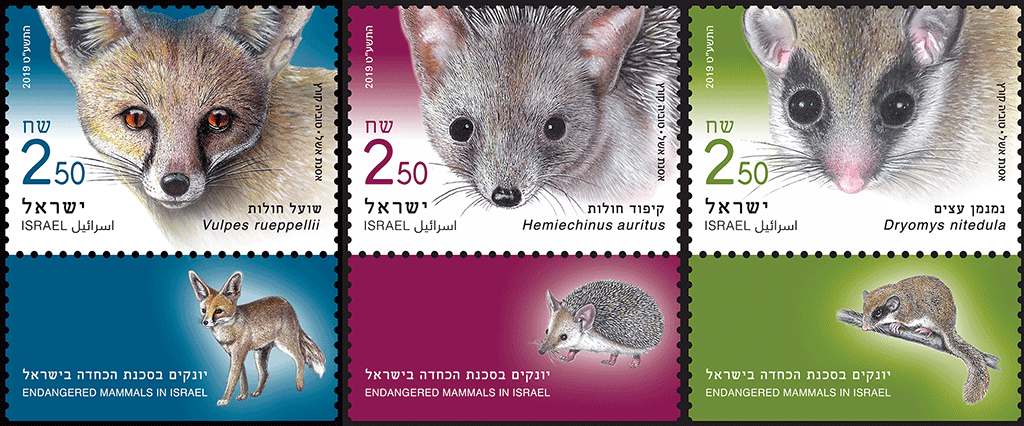
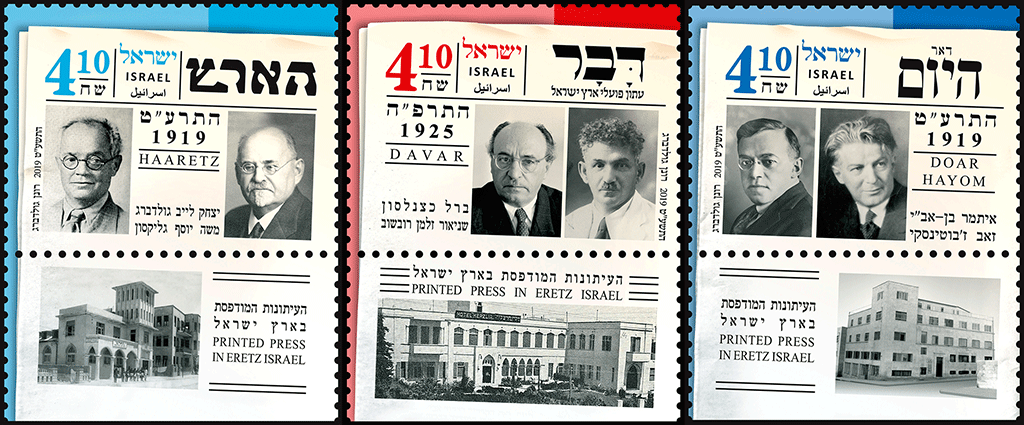
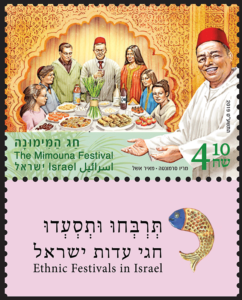
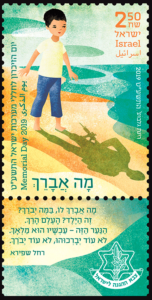


Israel’s May 2019 Issues:
Click on the issue names to go the specific pages.




 Three stamps: Vulpes rueppellii, Hemiechinus auritus, Dryomys nitedula
Three stamps: Vulpes rueppellii, Hemiechinus auritus, Dryomys nitedula
Date of Issue: 01 May 2019
Denominations: NIS 2.50,2.50,2.50
Size of Stamps: W: 40 mm H: 30 mm
Plate nos.: 1119
Designers: Tuvia Kurtz, Osnat Eshel
Printers: Cartor Security Printing, France
Printing method: Offset
Sheet type: Mini Special Sheet
No. of stamps in sheet: 9 (3 tabs)
Place of cancellation: Be’er Sheva
No. of FDCs: 1
Price of FDCs: NIS 8.70
From Israeli Post:
Three special mammal species in Israel have something in common – although each lives 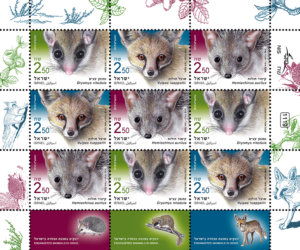 in a different area and habitat. All of these habitats are disappearing, be it loess covered areas, desert sands in the Negev or Mediterranean forests. The destruction of natural habitats is the most severe problem plaguing our world’s wildlife, and Israel is no exception.
in a different area and habitat. All of these habitats are disappearing, be it loess covered areas, desert sands in the Negev or Mediterranean forests. The destruction of natural habitats is the most severe problem plaguing our world’s wildlife, and Israel is no exception.
Wide open spaces that existed just 200 years ago have been populated. Fallow fields have become few and planted. The “wilderness” has been tamed by concrete and cement and crisscrossed by roads. All of these factors have contributed to the decrease and segmentation of natural habitats, making it difficult for wild animals in Israel to sustain their populations.
These three species are all nocturnal, thus they are seldom seen by humans, who may admire their beauty only for brief moments. They will cease to exist if we fail to make a 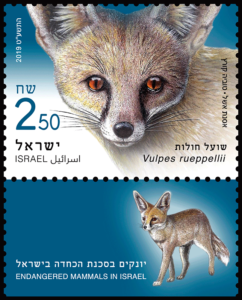 special effort to preserve them and their habitats.
special effort to preserve them and their habitats.
Rueppell’s Fox — Vulpes rueppellii
The Rueppell’s Fox is a small, beautiful species. It has a grey stripe running from the corner of its eye to its mouth and paws that are covered in fur as an adaptation to its sandy habitat. The Negev Desert is the northernmost distribution area of this species. In the 1980’s the population gradually disappeared from the sands of the Negev and Arava, due to the destruction from its displacement of its habitat by red foxes and wolves.
Forest Doormouse — Dryomys nitedula
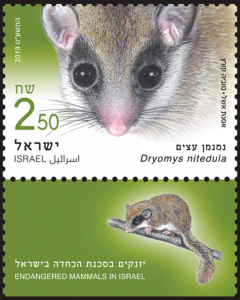 The Forest Doormouse is a small, stealth rodent that is active at night and few ever see it. It has a black “mask” on its face and a long, bushy tail. This species builds round nests in treetops, and spends its days sleeping there. At night it searches for acorns from oak trees and fruit in its
The Forest Doormouse is a small, stealth rodent that is active at night and few ever see it. It has a black “mask” on its face and a long, bushy tail. This species builds round nests in treetops, and spends its days sleeping there. At night it searches for acorns from oak trees and fruit in its
wooded Mediterranean habitat, using birds’ nests like tables. The Forest Doormouse may be found in the Galilee and was recently also seen in Jojoba groves in the northern Negev Desert. It is prevalent in the Balkans and southward to Israel, through Syria and Lebanon. Israel is the southernmost edge of its distribution.
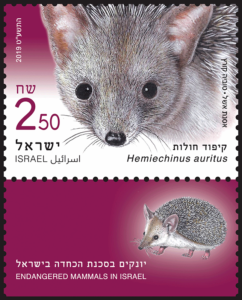 Long-eared Hedgehog — Hemiechinus auritus
Long-eared Hedgehog — Hemiechinus auritus
The Long-eared Hedgehog is the smallest hedgehog species in Israel. It has a light colored face, a pointed nose, large furless ears and no fur. It lives on the coastal plain as far as Caesarea in the north, in areas of loess sediment. There is an isolated population in the Golan Heights as well. The Long-eared Hedgehog may also be found in towns in the central of Israel, where it shares the urban habitat with Southern White-breasted Hedgehog.
—Keren Or
Zoologist, Zoological Center, Ramat Gan
 Date of Issue: 01 May 2019
Date of Issue: 01 May 2019
Denomination: NIS 4.10
Size of Stamp: W: 40 mm H: 30
Plate no.: 1120
Designers: Mario Sermonte, Meir Eshel
Printers: Cartor Security Printing, France
Printing method: Offset
Sheet type: Mini Special Sheet (Teth Besh Sheet)
No. of stamps in sheet: 8 (8 tabs)
Place of cancellation: Jerusalem
No. of FDCs: 1
Price of FDCs: NIS 5.30
From Israel Post:
When the State of Israel was founded and its gates were opened to Jews from around the world, the wave of Olim (new immigrants) which had been rising since the end of the 19th century became a virtual flood. Entire communities from around the globe gathered their belongings and made their way to the Land of their ancestors. Each community brought its customary garb, special language, traditions and all of the other cultural components it had developed over centuries in the Diaspora.
In the early years of the State, Israel’s leaders had to cope with the huge challenge of formulating a new society, one that would incorporate people from Jewish communities around the globe. As part of the “melting pot” concept the new immigrants were expected to abandon the traditions they brought from their native lands and embrace the image and traditions of the new Israeli. This attitude changed over the years and was replaced by one that honored and cherished the immense cultural wealth brought by the Olim. Israeli cuisine adopted diverse flavors and foods originating around the world, Israeli music enriched its work with a broad range of tones and the Israeli calendar integrated holidays and festivals celebrated by the different ethnic groups. Some of these festivals have spread beyond their original ethnicity and are celebrated by Israeli society as a whole.
The Mimouna Festival
 The Mimouna festival stems from the Jewish community in Morocco and is celebrated in the evening of the last day of Passover. The Mimouna is meant to unify the Jewish community and its essence is the opening of homes and hearts to all who wish to join in the celebration. It is customary to open one’s door as a sign that all are welcome – family, neighbors, acquaintances and strangers alike.
The Mimouna festival stems from the Jewish community in Morocco and is celebrated in the evening of the last day of Passover. The Mimouna is meant to unify the Jewish community and its essence is the opening of homes and hearts to all who wish to join in the celebration. It is customary to open one’s door as a sign that all are welcome – family, neighbors, acquaintances and strangers alike.
The hosts make every effort to provide their guests with an enjoyable experience. They are received with a traditional greeting: Tirbachu Utis’adu which wishes them success and good fortune. Participants wear splendid traditional garb, including golden robes and colorful head- coverings. The gathering is accompanied by music, singing and dancing.
The hosts traditionally serve a lavish and diverse array of delicacies and sweets, most of which are prepared during the days of Passover. These dishes are made with ingredients that are strictly kosher for Passover. Also served is the traditional Mufleta, which is made of dough and prepared at the end of the holiday, just before being served to the guests.
The festive atmosphere continues the next morning, and it is customary to spend the day outside with family and friends.
After coming to Israel, the Moroccan community continued to celebrate the festival within itself and in 1965 the tradition was established in the format of mass celebrations for the general public. The Mimouna festival has acquired a place of honor among Israelis and is celebrated each year by most people.
Description of the Stamp
Photos of the gate, the doors and the plant – Shutterstock.
Photo of the fish – Pnina Barkay.
Photos of the host’s clothing and hat and the photo that inspired the family – courtesy of the World Federation of Moroccan Jewry.
With thanks to the World Federation of Moroccan Jewry.
This is the first in a series of three stamps. Two additional stamps featuring the Sehrane and Sigd festivals will be issued later this year.
 Date of Issue: 01: May: 2019
Date of Issue: 01: May: 2019
Size of stamps: W: 30.mm H: 40 mm
Face Value: NIS 2.50:
Plate Block No.: 1114
Designer: Rinat Gilboa
Printing Method: Offset
Printer: Cartor Security Printing, France
Sheet Type: Regular
Stamps per sheet: 15
Tabs: 5
No. of FDCs: 1
Price of FDC’s: NIS 3.70
Place of cancellation: Jerusalem
From Israel Post:
The letter card, cover and stamp – all of which are special and unique to Memorial Day – constitute the basis of a sensitive, original and extraordinary tradition that came into being following the War of Independence.
Since Memorial Day 1952, a long line of Presidents, Prime Ministers and Ministers of Defense have signed personal letters to bereaved families of the fallen and Israel’s premier  artists take part in designing the covers and stamps for this commemorative day. Thus, from year to year, an unprecedented tradition has formed which, over time, has become one of the most recognized and extraordinary ambassadors of Israel’s commemorative culture.
artists take part in designing the covers and stamps for this commemorative day. Thus, from year to year, an unprecedented tradition has formed which, over time, has become one of the most recognized and extraordinary ambassadors of Israel’s commemorative culture.
(From: “Dear Families” published by the Ministry of Defense, on the occasion of Israel’s 50th Anniversary)
Over the years, the graphic design of the annual Memorial Day stamp has included symbolic expressions and monuments, and in recent years, also commemorative poems.
This stamp reflects the song Mah Avarech (How Shall I Bless Him) by Rachel Shapira.
What blessings can I give this child,
what can he be blessed with?
This boy is now an angel.
No one will bless him, he will be blessed no more.
© All rights reserved by the songwriter and ACUM. (Free translation from the original Hebrew)
 Date of Issue: 01 May 2019
Date of Issue: 01 May 2019
Size of stamp: W: 35 mm H: 50 mm
Face Value: NIS 11.80
Plate Block No. 1115
Designer: Tal Hoover
Printing Method: Offset
Printer: Cartor Security Printing, France
Sheet Type: Regular- Mini Sheet
Stamps per sheet: 10
Tabs: 5
No. of FDCs: 1
Price of FDCs: NIS 13
Place of cancellation: Jerusalem
Hava Nagila is one of the most famous Hebrew songs in the world, arguably the most recognized of all Hebrew melodies. The lyrics were apparently written by composer Zvi Idelsohn and his students at the Lemel School. Idelsohn was the first professional Jewish composer in Jerusalem and in all of Eretz Israel. He was also a vocal and music teacher, musical arranger, choir conductor, cantor and mentor to young cantors. In addition, he researched Jewish music, meticulously collecting and compiling thousands of Jewish melodies from all of the Jewish ethnic groups and tribes and was the first to record music in Eretz Israel.
The song was composed when 400 years of oppressive Turkish rule in Eretz Israel came to an end and the Jews of Jerusalem were enthusiastic and joyful after the British troops led by General Edmond Allenby entered the city on the first day of Hanukkah, 1917. During such moments of joy the Hallel prayer of praise is recited in synagogue: “This is the day that the Lord has made; let us exult and rejoice on it”.
Idelsohn decided to compose a song in honor of this great event and arranged the melody based on a Hasidic tune that he heard in the Hasidic court of the Sadigura Rebbe. The ancient melody stems from the courts of the Chernobyl Hasidic dynasty and was heard in most Hasidic courts.
 The song was first performed in 1918. It was later performed by many different artists, Jews and non-Jews alike. The melody was played at a dance in Jerusalem that same year, to great success. The words of the chorus are: “Let us rejoice and be glad, let us be happy, awaken brethren with a cheerful heart”.
The song was first performed in 1918. It was later performed by many different artists, Jews and non-Jews alike. The melody was played at a dance in Jerusalem that same year, to great success. The words of the chorus are: “Let us rejoice and be glad, let us be happy, awaken brethren with a cheerful heart”.
The song was recorded in the 1920’s and spread among the Jewish communities of Europe and America. It reached New York, a center for Jews and also the music world, and quickly gained popularity. The catchy, rhythmic tune and the simple Hebrew lyrics made it a hit among the Jewish population and it became the core of Jewish celebrations, sung at weddings, bar and bat mitzvahs, etc.
Non-Jewish singers also embraced and performed the song, thus expanding its popularity in the United States and later throughout the world, and it eventually became a musical standard. Although lyrics have been written in other languages, most renditions of the song feature all of the Hebrew lyrics and it is probably the most recognized Hebrew song in the world.
The First Day Cover features part of the musical score to Hava Nagila.
Three stamps: Haaretz, Davar, Doar Hayom
Date of Issue: 01 May 2019
Size of stamps: W: 40 mm H: 30 mm
Face Value: NIS 4.10, 4.10,4.10
Plate Block No. 1116, 1117, 1118
Designer: Ronen Goldberg
Printing Method: Offset
Printer: Cartor Security Printing, France
Sheet Type: Regular
Stamps per sheet: 15
Tabs: 5
No. of FDC’s: 1
Price of FDC’s: NIS 13.50
Place of cancellation: Jerusalem
From Israel Post:
The printed press has existed in Eretz Israel since 1863, mostly in Hebrew, along with some other languages as well. The first daily newspaper was published in 1908, but a wider range of daily newspapers did not appear until after WWI. In the summer of 1919, two dailies appeared within weeks of each other: News of Haaretz (which changed its name after a few months to Haaretz) and Doar Hayom.
Haaretz, 1919
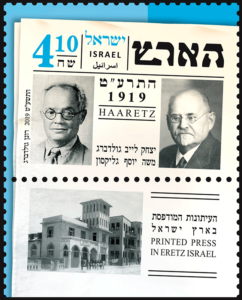 News of Haaretz was the civilian version of the British military weekly in Hebrew The Palestine News which was published for just one year (April 1918 – April 1919). When the British put it up for sale the Zionist Organization could not fund the purchase and called upon Isaac Leib Goldberg, a wealthy man and passionate Zionist from Eastern Europe, who acquired the newspaper and served as its first publisher.
News of Haaretz was the civilian version of the British military weekly in Hebrew The Palestine News which was published for just one year (April 1918 – April 1919). When the British put it up for sale the Zionist Organization could not fund the purchase and called upon Isaac Leib Goldberg, a wealthy man and passionate Zionist from Eastern Europe, who acquired the newspaper and served as its first publisher.
Goldberg retired from Haaretz after only a few years, but continued to support it financially and otherwise until his death in 1935.
The newspaper had significant financial troubles due to limited circulation and a lack of advertising, as the Jewish population numbered no more than 60,000. It had three different editors within three years: Nissan Turov, Shmuel Perlman and Leib Yaffe. The newspaper’s financial crisis led Haaretz to close in late 1922. It later reopened under editor Moshe Yosef Glikson, who served in this position for 15 years, until the newspaper was acquired by the Schocken family.
In 1923, Haaretz moved from Jerusalem to Tel Aviv, where it has remained ever since.
Davar, 1925
The third newspaper, Davar, was first published in the summer of 1925. It was the journal of the Histadrut Workers Organization, which was a rising organization at that time, led by 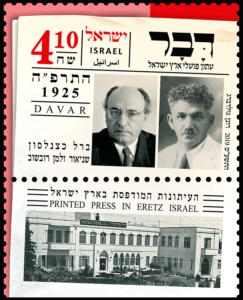 David Ben Gurion. The decision to publish a daily newspaper was made at the Histadrut’s founding convention in 1920, but its implementation was delayed by internal struggles within the organization. Berl Katznelson, the ideologist of the Labor Movement in Eretz Israel, founded Davar and served as its first editor. Shneur Zalman Rubashov (Shazar), later the third President of Israel, was his head assistant. Shazar succeeded Katznelson as the newspaper’s editor upon his death in 1944.
David Ben Gurion. The decision to publish a daily newspaper was made at the Histadrut’s founding convention in 1920, but its implementation was delayed by internal struggles within the organization. Berl Katznelson, the ideologist of the Labor Movement in Eretz Israel, founded Davar and served as its first editor. Shneur Zalman Rubashov (Shazar), later the third President of Israel, was his head assistant. Shazar succeeded Katznelson as the newspaper’s editor upon his death in 1944.
Davar, as opposed to the other newspapers, established an “empire” of publications that included the punctuated daily Hege (that was later called Omer) as well as weekly, biweekly and monthly publications such as Davar for Children, Davar for Women Workers, Davar for the New Immigrant, Hameshek Hashitufi, a magazine in Arabic called Hakikat Al-Amar (The Word of Truth), as well as newspapers in English and German and an annual literary publication. Davar for Children was considered to be the leading children’s newspaper in Israel for more than 50 years.
Davar was the most popular and influential newspaper in Israel for many years. It was published in Tel Aviv for 71 years, until its closure in 1996.
Doar Hayom, 1919
The founders of Doar Hayom, Eliezer Ben-Yehuda and his son Itamar Ben-Avi were initially among the first at Haaretz but after only a few weeks they left and started their own 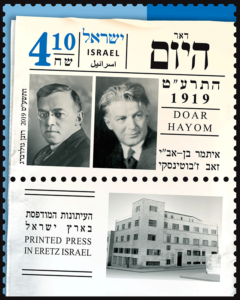 newspaper. Editor Itamar Ben-Avi derived the name of the Jerusalem-based newspaper from London’s Daily Mail. The right-wing Doar Hayom represented the veteran members of the Jewish Yishuv in Eretz Israel, the Sephardim and the farmers as opposed to the mid-left wing Haaretz and tended to publish more “scoops”, amusing stories from around the world and personal attacks on the heads of the Zionist movement and the Yishuv. Ben-Avi loathed Haaretz and used to say mockingly: “Haaretz may be a decent newspaper – but it isn’t a newspaper; Doar Hayom may not be decent, but it is a newspaper”.
newspaper. Editor Itamar Ben-Avi derived the name of the Jerusalem-based newspaper from London’s Daily Mail. The right-wing Doar Hayom represented the veteran members of the Jewish Yishuv in Eretz Israel, the Sephardim and the farmers as opposed to the mid-left wing Haaretz and tended to publish more “scoops”, amusing stories from around the world and personal attacks on the heads of the Zionist movement and the Yishuv. Ben-Avi loathed Haaretz and used to say mockingly: “Haaretz may be a decent newspaper – but it isn’t a newspaper; Doar Hayom may not be decent, but it is a newspaper”.
In late 1928, when Doar Hayom was actually the most popular newspaper in Eretz Israel, Ben-Avi inexplicably transferred the editor’s position to Ze’ev Jabotinsky, who turned it into the journal of the young Revisionist Movement. Two years later, the newspaper returned to Ben-Avi, who served as its editor until he retired in 1933. The newspaper continued to exist sporadically until 1940.
Doar Hayom was mostly published in Jerusalem.
—Dr. Mordecai Naor
The Buildings on the Stamps
The three buildings featured on the stamps housed the three newspapers – Haaretz, Doar Hayom and Davar.
The first building to house Haaretz was built by I.L. Goldberg on Montefiore St. in Tel Aviv (as featured on the stamp). The newspaper later moved to Mazeh St., where it remained for decades. Doar Hayom was housed in an office building on Hasolel St. in the center of Jerusalem. Hasolel was the name of the publishing company that published the newspaper. Today it is called Havazelet St., named after the second newspaper to appear in Jerusalem, in 1863, (the first was Halevanon).
For many years, Davar was housed in the Histadrut Executive Committee building on Allenby St. in Tel Aviv (which appears on the stamp). In the late 1940’s the newspaper moved to its own building on Shenkin St.
[press release]
Terschelling gets own stamp
Focus on nature and architecture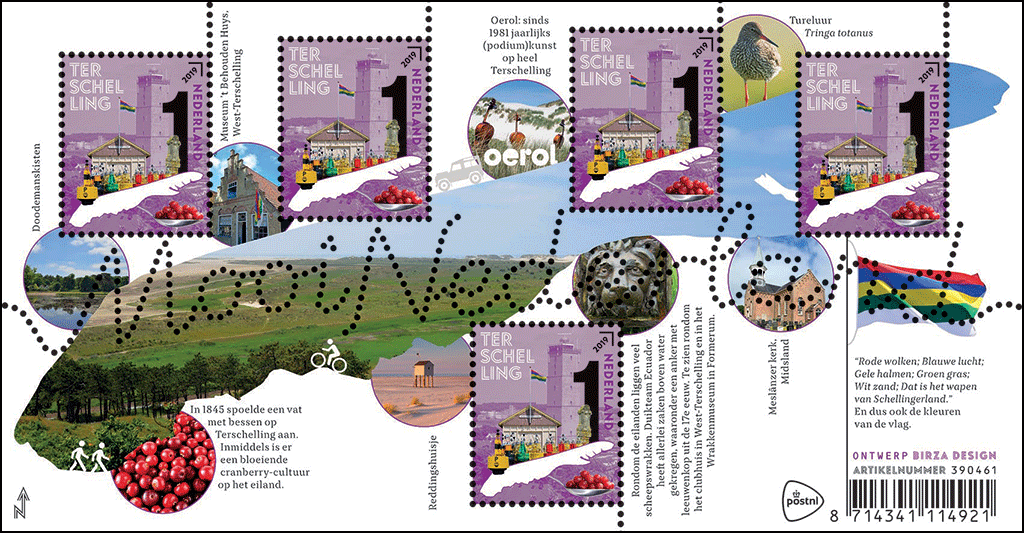
The Hague, March 25, 2019 – The well-known stamp series Beautiful Netherlands in 2019 is dominated by the Dutch Wadden. Today is the third stamp published in this series, with ample attention to the nature and architecture of Terschelling. Earlier this year already appeared on stamps Texel and Vlieland, Ameland and Schiermonnikoog later turn. PostNL also brings a collective sheet on all five islands.
Scenic Beauty
The Beautiful Netherlands series pays attention since 2005 to local history, cultural wealth and natural beauty. The new series this year on the Dutch Wadden designed by Birza Design in Deventer.
Recognizable Images of Terschelling
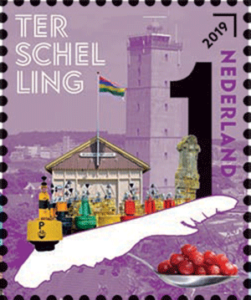 In the design of the Beautiful Netherlands 2019: Terschelling island shape plays the leading role. This is reflected in the map of Terschelling, who placed the designers in miniature on the stamps and wholesale on the stamp. The stamps are recognizable images of the island: the Brandaris as the oldest lighthouse in the Netherlands, a monumental tombstone in Strieperkerkhof, the clubhouse of the diving team Ecuador, a row of colorful buoys on the town wharf and a spoon with cranberries. The design turns the typical shape of the island is also back in other ways. For example, the font of the labels is a so-called letter box, composed of elements that are separate from each other.
In the design of the Beautiful Netherlands 2019: Terschelling island shape plays the leading role. This is reflected in the map of Terschelling, who placed the designers in miniature on the stamps and wholesale on the stamp. The stamps are recognizable images of the island: the Brandaris as the oldest lighthouse in the Netherlands, a monumental tombstone in Strieperkerkhof, the clubhouse of the diving team Ecuador, a row of colorful buoys on the town wharf and a spoon with cranberries. The design turns the typical shape of the island is also back in other ways. For example, the font of the labels is a so-called letter box, composed of elements that are separate from each other.
Impressive Nature, Giant Beaches
Almost all dating used photos of a visit to Terschelling by graphic designers and Ingmar Carla Birza, in the sunny summer of 2018. Carla Birza Terschelling describes as an island “where the role of the sea in all respects recognizable. The nature is impressive, especially at the point where the panorama was taken. There you can look around 360 degrees stunning, both the Wadden Sea and the North Sea. I was deeply impressed, I want to go back again. Magnificent dune forest too. And the gigantic natural beaches are magnificent. ”
Availability
The stamp Beautiful Netherlands 2019: Terschelling has five identical stamps with the denomination Netherlands 1, intended for mail up to 20 grams with a destination within the Netherlands. The stamps are available from TNT locations on the island of Terschelling and through March 25, 2019 from the website . The stamps can be ordered by calling the customer service Collect Club at telephone 088-868 99 00. The term of validity is undetermined.
[press release; see below for the first-day press release and illustrations]
Canadians in Flight stamp issue honours pilots, designers and aircraft
Join us at the Canada Aviation and Space Museum
OTTAWA, March 21, 2019 /CNW/ – On Tuesday, March 26, Canada Post will unveil five stamps that celebrate the heights of ingenuity and courage by honouring Canadians and aircraft that made their mark on civilian and military aviation.
WHAT: Canada Post unveils all five stamps from the Canadians in Flight issue, which will include stamps honouring First World War ace William George Barker, VC, and the pioneering Lazair ultralight plane. The remaining three stamp subjects have not yet been announced.
WHO: Interview opportunities will be available with representatives from the Canada Aviation and Space Museum, Canada Post, and special guest Dale Kramer, designer of the Lazair ultralight plane.
WHERE: Canada Aviation and Space Museum
11 Aviation Parkway
Ottawa, Ont.
WHEN: Tuesday, March 26
11 a.m. to 1 p.m.
[issuance press release]
Canadians in Flight stamp issue honours pilots, designers and aircraft that made aviation history
An ace, a bush pilot, the Queen of the Hurricanes, an ultralight and the Avro Arrow all soar again on stamps  Canada Post has issued five stamps that celebrate legendary examples of Canadian ingenuity, technological prowess and courage in civilian and military aviation. Developed with the support of the Canada Aviation and Space Museum – one of three museums under the Ingenium brand – the stamps commemorate:
Canada Post has issued five stamps that celebrate legendary examples of Canadian ingenuity, technological prowess and courage in civilian and military aviation. Developed with the support of the Canada Aviation and Space Museum – one of three museums under the Ingenium brand – the stamps commemorate:
 A First World War pilot, William George Barker, VC, who remains the most decorated member of the military in the history of Canada and the British Empire. Barker flew more than 900 combat hours between 1916 and 1918 and is credited with 50 victories over enemy aircraft.
A First World War pilot, William George Barker, VC, who remains the most decorated member of the military in the history of Canada and the British Empire. Barker flew more than 900 combat hours between 1916 and 1918 and is credited with 50 victories over enemy aircraft. Aviation pioneer and bush pilot C.H. “Punch” Dickins, who logged more than 1.6 million kilometres flying over northern Canada. The First World War flying ace and Distinguished Flying Cross recipient made the first reconnaissance flight across the unmapped Barren Lands of the Northwest Territories.
Aviation pioneer and bush pilot C.H. “Punch” Dickins, who logged more than 1.6 million kilometres flying over northern Canada. The First World War flying ace and Distinguished Flying Cross recipient made the first reconnaissance flight across the unmapped Barren Lands of the Northwest Territories. Elizabeth “Elsie” MacGill, who was the first woman in Canada to receive a degree in electrical engineering, and first in the world to hold a master’s degree in aeronautical engineering and to work as a professional aircraft designer. She was dubbed “Queen of the Hurricanes” in a wartime comic book for her work in overseeing design refinements and production of Hawker Hurricanes. The fighter plane was a stalwart workhorse in the Second World War, and especially the Battle of Britain.
Elizabeth “Elsie” MacGill, who was the first woman in Canada to receive a degree in electrical engineering, and first in the world to hold a master’s degree in aeronautical engineering and to work as a professional aircraft designer. She was dubbed “Queen of the Hurricanes” in a wartime comic book for her work in overseeing design refinements and production of Hawker Hurricanes. The fighter plane was a stalwart workhorse in the Second World War, and especially the Battle of Britain.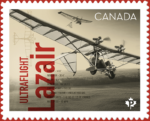 The Lazair, a family of twin-engine, high-wing ultralight monoplanes designed by Dale Kramer of Port Colborne, Ontario. Manufactured as kits in Canada between 1979 and 1985, the Lazair is still considered one of the best light aircraft ever made. Kramer received the Roméo Vachon Award in 1983 for outstanding contribution to the development of aeronautics in Canada.
The Lazair, a family of twin-engine, high-wing ultralight monoplanes designed by Dale Kramer of Port Colborne, Ontario. Manufactured as kits in Canada between 1979 and 1985, the Lazair is still considered one of the best light aircraft ever made. Kramer received the Roméo Vachon Award in 1983 for outstanding contribution to the development of aeronautics in Canada. The twin-engine, supersonic Avro CF-105 Arrow interceptor, which could fly at more than twice the speed of sound. It is considered one of the greatest technological achievements in Canadian aviation history. Some of its innovative technologies are still in use today.
The twin-engine, supersonic Avro CF-105 Arrow interceptor, which could fly at more than twice the speed of sound. It is considered one of the greatest technological achievements in Canadian aviation history. Some of its innovative technologies are still in use today.“As Canada’s storyteller, Canada Post is proud to share these stories of personal bravery and ingenuity, and to commemorate the aircraft that demonstrate Canadian technological innovation,” says Doug Ettinger, Canada Post President and CEO.
“Ingenium is thrilled that our collection has helped to bring these ground-breaking moments in Canadian aviation to life. We hope that by sharing stories of those who dared to think differently, we inspire ingenuity, creativity, and innovation in all Canadians,” says  Christina Tessier, President and CEO of Ingenium – Canada’s Museums of Science and Innovation.
Christina Tessier, President and CEO of Ingenium – Canada’s Museums of Science and Innovation.
The stamp issue, designed by Ivan Novotny of Taylor|Sprules and printed by the Lowe-Martin Group, is available in a booklet of 10 (two of each design) and a gummed mini-pane of five. Five Official First Day Covers are also available as a set or separately.
The stamps and related collectibles are available at canadapost.ca and at postal outlets across Canada. 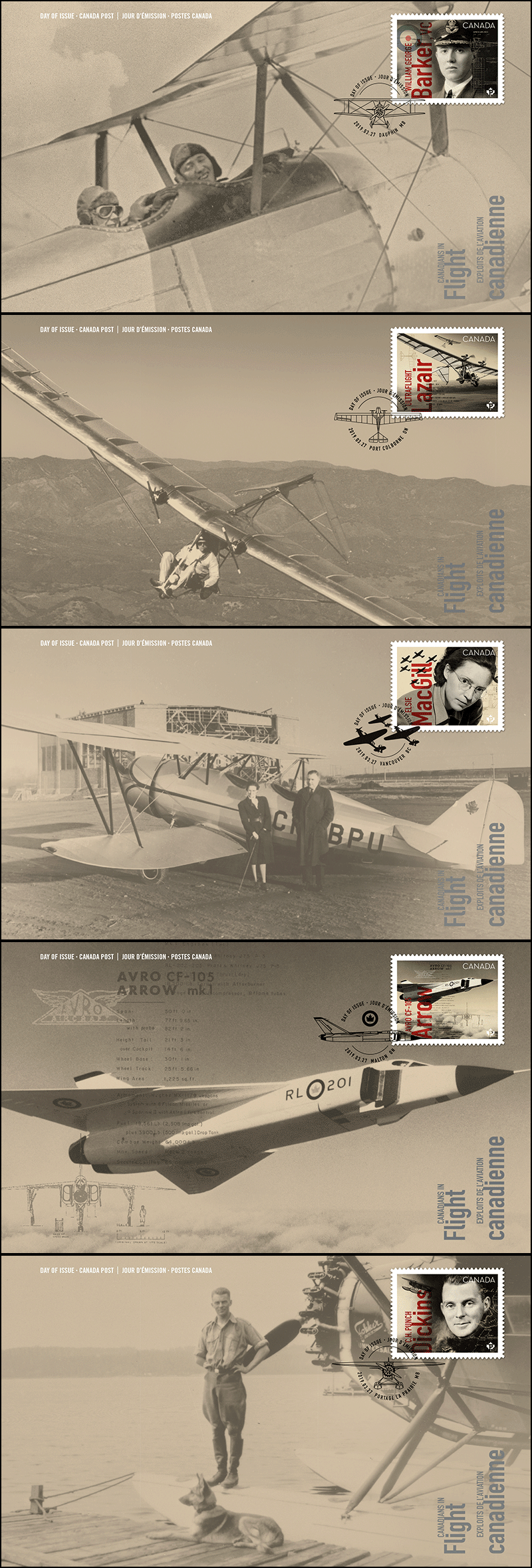
[press release]
100 years fly by  The Hague, 14 March 2019. In 2019 it was 100 years ago that the Royal Dutch Airlines (KLM) and the Netherlands Aerospace Centre (NLR) were founded. In that year Fokker built the first aeroplanes on Dutch soil. PostNL honours this special centenary celebration with the issuance of the 100 Years of Aviation postage stamp sheet.
The Hague, 14 March 2019. In 2019 it was 100 years ago that the Royal Dutch Airlines (KLM) and the Netherlands Aerospace Centre (NLR) were founded. In that year Fokker built the first aeroplanes on Dutch soil. PostNL honours this special centenary celebration with the issuance of the 100 Years of Aviation postage stamp sheet.
11 aeroplanes
The 100 Years of Aviation postage stamp sheet consists of 3 stamps and shows 11 aeroplanes as major orientation points in the historical development and also the future of the 3 organisations. The stamps were designed by Edwin van Praet and Tim Hölscher of Total Design from Amsterdam.
From the very first to the very latest
The designers selected well-known and less well-known aeroplanes from 100 years of Dutch aviation. It starts with the F.II, the very first Fokker that was put into operation by KLM. And the last plane on the postage stamp sheet is the NLR Hybrid Electric Plane (concept), which is expected to fly around 2050. In between a parade of aeroplanes will fly by, including the KLM DC-2 Uiver, the Fokker F27 Friendship and the very latest Boeing 787-10, which KLM will start to operate this anniversary year.
3 jubilees
KLM started in 1919 as the Royal Dutch Airlines for the Netherlands and Colonies and is the oldest airline company still operating under its original name. Anthony Fokker also founded the Dutch Aeroplane Factory in 1919, which would later be named after him. Finally, 1919 was the year of the foundation of the National Study Office for Aviation, which nowadays is called NLR, the central institute for aviation and space research in the Netherlands.
Emphasis on the fairy tale
In honour of the celebrating parties Herna Verhagen, managing director of PostNL, presented the postage stamp sheet to Minister Cora van Nieuwenhuizen in the Eye Film Museum in Amsterdam this afternoon during the event 100 years of aviation in the Netherlands. Verhagen: “The special jubilee of 3 major icons from aviation, which are inextricably linked, should be accompanied by a special stamp. Certainly when you consider the ties that already existed between PTT, KLM and Fokker from the very start. Aviation has played an important role for (international) post. The cooperation between PTT and KLM was of great economic importance for both parties.”
Availability
The 100 Years of Aviation postage stamp sheet consists of 3 stamps, all marked with Nederland 1, the denomination for mail weighing up to 20 g destined for the Netherlands. The stamps are available as of 11 March 2019 from the post office counter in Bruna stores and online at www.postnl.nl/bijzondere-postzegels. The stamps can also be ordered by phone from the Collect Club customer service on telephone number +31 (0)88 – 868 99 00. The validity period is indefinite.
Announced March 12th: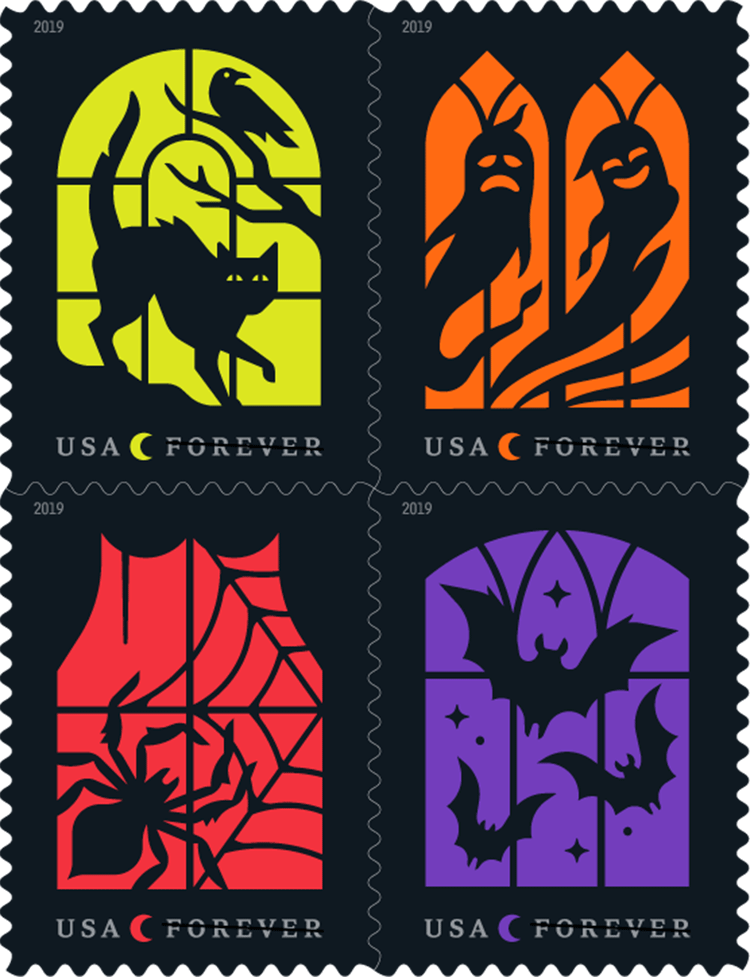
Halloween has long been a holiday that lets us delight in the things that scare us. With the approach of autumn, Spooky Silhouettes stamps will offer fun, frightful scenes that symbolize this annual celebration. Four stamps feature digital illustrations in which traditional Halloween motifs are rendered as black silhouettes in eerily backlit windows. Artist Tyler Lang created the artwork. Art Director Greg Breeding designed the stamps.
No date or first-day city were given. Further updates will appear below, in order announced.
Updated December 5th:
The Scott catalogue numbers for this issue are:
5420 (55¢) Spooky Silhouettes – Cat and Raven
5421 (55¢) Spooky Silhouettes – Ghosts
5422 (55¢) Spooky Silhouettes – Spider and Web
5423 (55¢) Spooky Silhouettes – Bats
a. Block of 4, #5420-5423
Updated September 26th:
Here are the first day postmarks for this issue: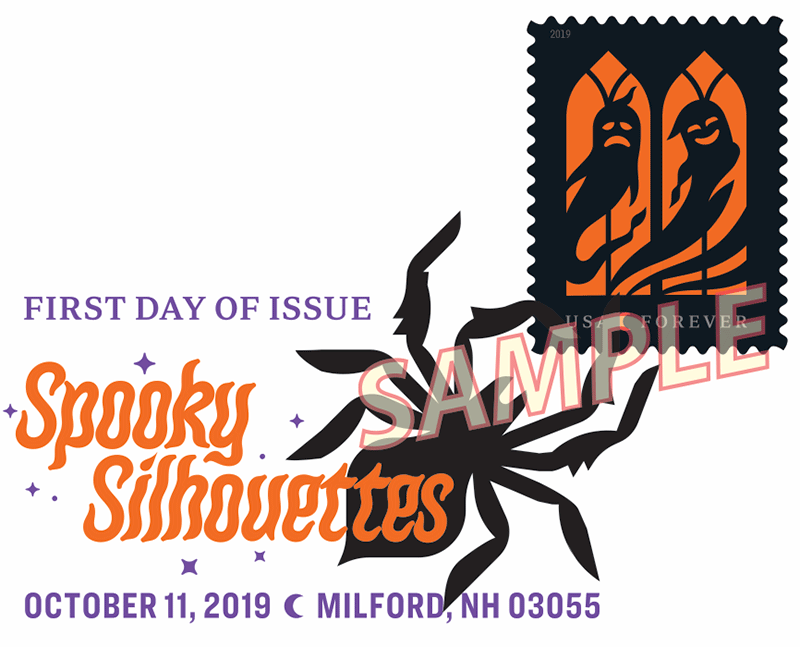 The Digital Color Postmark for this issue measures 2.37″ x 1.49″
The Digital Color Postmark for this issue measures 2.37″ x 1.49″ 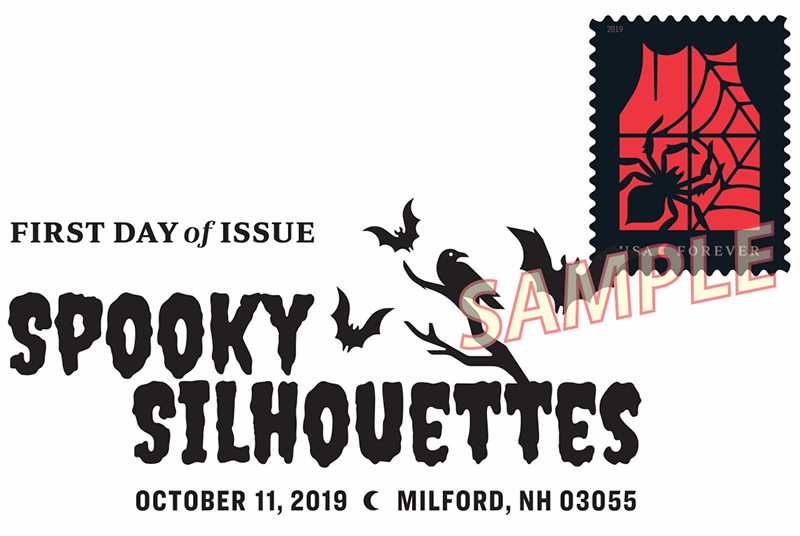 The B&W pictorial postmark measures 2.96″ x 1.48″
The B&W pictorial postmark measures 2.96″ x 1.48″
On October 11, 2019, the United States Postal Service will issue the Spooky Silhouettes stamps (Forever® priced at the First-Class Mail rate) in four designs, in a pressure-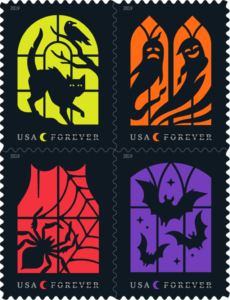 sensitive adhesive (PSA) pane of 20 stamps (Item 572200). The stamps will go on sale nationwide October 11, 2019, and must not be sold or canceled before the first-day-of-issue. The Spooky Silhouettes pane of 20 stamps may not be split and the stamps may not be sold individually.
sensitive adhesive (PSA) pane of 20 stamps (Item 572200). The stamps will go on sale nationwide October 11, 2019, and must not be sold or canceled before the first-day-of-issue. The Spooky Silhouettes pane of 20 stamps may not be split and the stamps may not be sold individually.
Halloween has long been a holiday that lets us delight in the things that scare us. As autumn approaches, these new stamps offer fun, frightful scenes that symbolize this annual celebration. Four stamps feature digital illustrations in which traditional Halloween motifs are rendered as black silhouettes in eerily backlit windows. Artist Tyler Lang created the artwork. Art director Greg Breeding designed the stamps.
Availability to Post Offices: Item 572200 Spooky Silhouettes (Forever Priced at the First-Class Mail Rate) PSA Pane of 20 Stamps. Stamp Fulfillment Services will make an automatic push distribution to Post Offices of a quantity to cover approximately 30 days of sales.
How to Order the First-Day-of-Issue Postmark:
Customers have 120 days to obtain the first-day-of-issue postmark by mail. They may purchase new stamps at their local Post Office™ or at The Postal Store® website at usps.com/shop. They must affix the stamps to envelopes of their choice, address the envelopes (to themselves or others), and place them in a larger envelope addressed to:
FDOI – Spooky Silhouettes Stamps
USPS Stamp Fulfillment Services
8300 NE Underground Drive, Suite 300
Kansas City, MO 64144-9900
After applying the first-day-of-issue postmark, the Postal Service™ will return the envelopes through the mail. There is no charge for the postmark up to a quantity of 50. There is a 5-cent charge for each additional postmark over 50. The deadline is February 11, 2020.
Technical Specifications:
Issue: Spooky Silhouettes Stamps
Item Number: 572200
 Denomination & Type of Issue: First-Class Mail Forever
Denomination & Type of Issue: First-Class Mail Forever
Format: Pane of 20 (4 designs)
Series: N/A
Issue Date & City: October 11, 2019, Milford, NH 03055
Art Director: Greg Breeding, Charlottesville, VA
Designer: Greg Breeding, Charlottesville, VA
Typographer: Greg Breeding, Charlottesville, VA
Artist: Tyler Lang, Milwaukie, OR
Modeler: Joseph Sheeran
Manufacturing Process: Flexographic, Rainbow Foil
Printer: Ashton Potter (USA) Ltd. (APU)
Press Type: Arsoma EM 410
Stamps per Pane: 20
Print Quantity: 40,000,000 stamps
Paper Type: Nonphosphored Type III, Block Tag
Adhesive Type: Pressure-sensitive
Processed at: Ashton Potter (USA) Ltd. (APU)
Stamp Orientation: Vertical
Image Area (w x h): 0.73 x 1.05 in./18.542 x 26.67 mm
Stamp Size (w x h): 0.91 x 1.19 in./23.114 x 30.226 mm
Full Pane Size (w x h): 5.3625 x 6.5 in./136.208 x 165.1 mm
Press Sheet Size (w x h): 21.45 x 13.375 in./ 544.83 x 339.725 mm
Colors: PMS Cool Grey 6, PMS 266C Purple, PMS 032C Red, PMS 1585C Orange, PMS 388C Yellow, Black
Plate Size: 160 stamps per revolution
Plate Number: “P” followed by six (6) single digits
Marginal Markings:
Front: Header: Spooky Silhouettes • Plate numbers in bottom two corners
Back: ©2019 USPS • USPS logo • Two barcodes (572200) • Promotional text • Plate position diagram
Updated September 10th:
These stamps will be issued October 11th in Milford, NH.
[press release]
Cats, Bats and Spiders, Oh My!
Spooky Silhouettes Forever Stamps to be Released in Time for Halloween
 WHAT: The Postal Service issues four Forever stamps in time for Halloween. The Spooky Silhouettes stamps feature digital illustrations with Halloween motifs rendered as black silhouettes in eerily backlit windows. The images include a cat with an arched back beneath a raven perched on a bare tree branch, all against a yellowish-green background; two ghosts against an orange background; a spider and a web against a red background; and three bats against a purple background.
WHAT: The Postal Service issues four Forever stamps in time for Halloween. The Spooky Silhouettes stamps feature digital illustrations with Halloween motifs rendered as black silhouettes in eerily backlit windows. The images include a cat with an arched back beneath a raven perched on a bare tree branch, all against a yellowish-green background; two ghosts against an orange background; a spider and a web against a red background; and three bats against a purple background.
News of the stamps is being shared with the hashtag #HalloweenStamps.
WHO: Marc McCrery, vice president of mail entry and payment technology, U.S. Postal Service
WHEN: Friday, Oct. 11 at 5 p.m. EDT
WHERE: Milford Pumpkin Festival
Emerson Park Stage
6 Mont Vernon St.
Milford, NH 03055
RSVP: Dedication ceremony attendees are encouraged to RSVP at usps.com/silhouettes.
WHY: As autumn approaches, these new stamps offer fun, frightful scenes that symbolize Halloween. With customs and traditions that vary widely by community, Halloween now inspires parades and carnivals, corn mazes, haunted houses, neighborhood and school parties, pumpkin festivals, and even pumpkin catapulting. Halloween remains a much-anticipated celebration of the macabre in the face of approaching winter.
Artist Tyler Lang worked with art director and designer Greg Breeding to create these stamps, which will be available for purchase Oct. 11. Additional details will be provided before the ceremony date.


